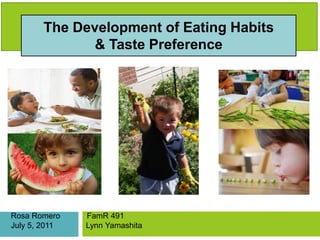
Development of eating habits and food preference final
- 1. The Development of Eating Habits & Taste Preference Rosa Romero FamR 491 July 5, 2011 Lynn Yamashita
- 2. State of Children’s Health in U.S. 1in 3 children are obese or overweight by their 5th Birthday (CDC, 2011) Children do not meet minimum suggestions of daily fruit and vegetables Excess of fat, sugar and salt in diet (WHO, 2004) To healthify the American diet crucial to first understand how food habits and taste preferences are formed Obesity = Malnutrition
- 3. Effects of poor diets in early childhood Short term- Tooth decay, lack of energy, overweight, mood swings Long term possible developmental delays and cognitive deficits, specifically executive function (Smith et al, 2011) Diet related conditions in adolescence and adulthood Hypertension: Infants with high salt diets had high blood pressure at age 15 (Geleijne et al, 1997) Diabetes: Sugary drinks primary cause for diabetes in children (Piernas, Popkin, 2011)
- 4. Guiding Questions Are preferences innate or learned? What tastes are developed first? What role does food neophobia play? What factors shapes taste preferences? By what age are most taste preferences formed? What role do parents and caregivers have?
- 5. Nature or Nurture? Physiological Exposure development Peer & adult modeling Genetic Culture predisposition Marketing Environment
- 6. Taste Development in Infancy Infants have an innate preference for sweet (Rosenstein & Oster 1988, Scwatz et al, 2009) Infants are neutral in response to salt, however some preference is shown by 4 months. (Harris, Thomas & booth, 1990) Children show preference to sugar and salty food they are exposed to over time (Sullican & Birch, 1990)
- 7. Mothers diet The Carrot Study (Mennella, Jagnow&Beauchamp, 2001) Infant exposure to carrots in amniotic fluid or breast milk enjoyed carrot flavor more than infants not exposed to it. Conclusion: prenatal and early post natal exposure enhanced the infants’ enjoyment of that flavor during weaning Early flavor experiences may explain cultural and ethnic differences in cuisine
- 8. Food Neophobia Natural reluctance in humans to consume new or unusual foods (Stallberg, White & Pliner, 1999) First 2 years, relatively weak food neophobia (Birch, Marlin, 1982) Toddlers discovery of their power could led them to be “picky eaters”, picking eating toddlers become picky eating adults (Carruth & Skinner, 2000) Children's food neophobias resembles their parents (Logue, Uzzo, McCaty & Smith, 1998)
- 9. Food Preferences…. Are learned through Exposure Exposure frequency Experience with food By age 3, most children can rank order their preferences (Birch & fisher, 1996) New foods more easily accepted before 4 years old Strongest predictor of what foods liked at age 8 are what foods are liked by age 4 (Skinner et al, 2002) Food preferences become food habits
- 10. Modeling Parent role is central, children model their eating Food intake patterns of parents and their children are similar (Fisher, et al, 2002) Children tend to sample “unfamiliar” foods when they see an adult eating it than when merely offered (Harper & Sauders, 1975) Childcare becoming primary learning environment for developing food habits (Briley & McAllaster, 2011) With age, adult modeling becomes overshadowed by peer modeling (Birch 1999)
- 11. Mixed messages about food “Foods as rewards” Increases binge eating as adults (Pahl, 2003) “Finish your veggies” Creates a negative association carried out through adulthood (Fisher & Birch, 1990) Eat this, while eat I this Most children start on a diet rich in fruits and vegetables but decreases with age (Carruth & Skinner, 2000) Trix are for kids!!! 80% of commercials during cartoons are for fast foods and sweets Increased TV viewing equates with an increase intake of salty and sugar snacks (NAIH, 2005)
- 12. What you can do to help children develop healthy habits? Be a role model and eat more fruits and vegetables and less sugared drinks Increase early exposure to a variety of fruits and vegetables Garden, cook & eat together Look for non food rewards such as choosing the family movie or allowing a sleep over Create family and school traditions that don’t revolve around unhealthy food Teach which foods are “sometimes” foods
- 13. Cute food art ;)
Notes de l'éditeur
- are not meeting the minimum suggested consumption goals of 400 g/day (Health Behaviour in School-aged Children (HBSC) study, 2001, [Pomerleau et al., 2004]
- More children than ever being diagnosed with diabetes, as young as 5 years old!!
- -A preference for sweet and rejection of sour or bitter food present in newborn infants (Rosenstein & Oster 1988, Scwatz et al, 2009)-Children fed a lower salt diet show less preference for salt than children fed a high salt diet
- Food neophobia is a naturally occurring reaction in humans that protect individuals from the risk of being poisoned by consuming potentially harmful foods. It accounts for a person’s reluctance to consume either new or unusual foods, based on one’s culture and current diet (Rozin, 1997; Stallberg-White & Pliner;, 1999). Individuals may perceive and expect how an acceptable food should look and smell. As a consequence, an unfamiliar food that does not fall into one’s acceptable category will be rejected (Dovey et al., 2008). However, food neophobia may affects food choice and limits overall dietary variety especially in children (Pliner & Melo;, 1996; Falciglia et al., 2000; Skinner et al., 2002).Affects food choice and limits overall dietary variety, especially in children (Skinner, et al, 2002)Talk about weaning- veggies first, could see affect CAREFUL MAY BE AN ALLERGY!!!!!
- 10 to 15 times for a baby/child to learn to like a new food, don’t give up.